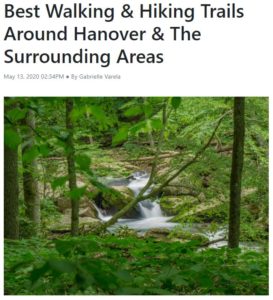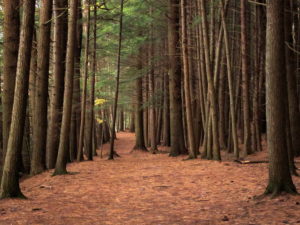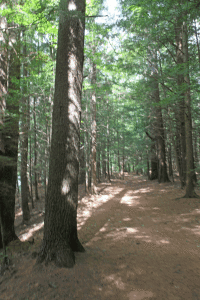At last night’s Hanover Town Meeting, residents voted to approve a $500,000 contribution towards the purchase of the Mink Brook Community Forest from reserve and conservation funds held by the Town. From the Valley News, “Plans to turn 260 acres of woods and old farmland along both sides of Greensboro Road into a town forest also were OK’d on Tuesday. Residents voted by a show of hands to spend $500,000 to help purchase land which crosses Mink Brook and includes a brick farmhouse from 1850. The Trust for Public Land, assisted by the Hanover Conservancy, hopes to spend $2.5 million acquiring the property from the Leavitt family. So far, an anonymous donor has footed $500,000 to help the project, which also received a $600,000 community forest program grant from the U.S. Forest Service. None of the town’s share will come from new taxes, and will instead be taken from existing reserve and conservation funds. Officials also hope to sell the property’s farmhouse to help finance the overall project, and a separate four acres could be used by Twin Pines Housing Trust to build “a small cluster of affordable cottage-style homes targeted to new homeowners,” according to an April news release.”
Mink Brook Community Forest meeting now on our YouTube channel!
NEW! Watch the May 27th, 2020 recording of a Zoom informational meeting on the Mink Brook Community Forest project. The call was led by JT Horn, Senior Project Manager for the Trust for Public Land and Rob Houseman, Planning Director for the Town of Hanover.
Mink Brook Featured in Here in Hanover’s List of Local Hikes
 As a reminder, the Quinn Trail will be closed for repairs May 18-21, but all other trails are open and can be accessed from Buck Road, Sachem/DHMC/Boston Lot network, or Route 10 (park on grass just across from Pine Knoll Cemetery). Read the full list of recommended hikes here.
As a reminder, the Quinn Trail will be closed for repairs May 18-21, but all other trails are open and can be accessed from Buck Road, Sachem/DHMC/Boston Lot network, or Route 10 (park on grass just across from Pine Knoll Cemetery). Read the full list of recommended hikes here.
Hot off the press!
We’re excited to be featured in the fall issue of Here in Hanover magazine! Pick up your copy around town or share the article with friends online.

NEW website for Pine Park
The Pine Park Association has a new website!
Stay up to date and learn more about this beloved area at PinePark.org.
 Pine Park is a treasure in so many ways…
Pine Park is a treasure in so many ways…
— scenic, forested Connecticut River shoreline – near downtown!
— beautiful trails, linking the campus and nearby neighborhoods
— protected corridor & shaded fish habitat for Girl Brook, one of Hanover’s most vulnerable streams
— stopover habitat for spring migrating birds
— shelter for wildlife
Here’s more from our friends at the Pine Park Association:
Pine Park is Hanover’s first natural area permanently preserved as a park and today functions as the town’s “central park” for the enjoyment of walkers, joggers, skiers and many others. TRAILS MAP
The Park’s 95 acres, acquired between 1900 and 1912, represent an important ecological resource, where riparian and forest ecosystems intersect. Accessed through the Hanover Country Club, off Rope Ferry and Occom Ridge roads north of the Dartmouth College campus, the park features a significant stand of old white pine, hemlock and hardwoods. The land is home to deer and black bear, among many other woodland animals, as well as to some unusual and endangered plant species.
 Historically, the town of Hanover and Dartmouth College have shared responsibility for the management of the park, and both periodically offer labor and expertise in connection with its preservation. However, neither contributes funding directly for park maintenance or capital improvement. The park is owned by the Pine Park Association, a voluntary nonprofit that dates back to 1900, when a group of 17 local residents sought to prevent the Diamond Match Company from harvesting trees along the riverbank just north of the Ledyard Bridge.
Historically, the town of Hanover and Dartmouth College have shared responsibility for the management of the park, and both periodically offer labor and expertise in connection with its preservation. However, neither contributes funding directly for park maintenance or capital improvement. The park is owned by the Pine Park Association, a voluntary nonprofit that dates back to 1900, when a group of 17 local residents sought to prevent the Diamond Match Company from harvesting trees along the riverbank just north of the Ledyard Bridge.
Conditions in the park have deteriorated in recent years, in part because of an aging canopy affected by a disease known as needle cast, and because of development that has contributed to notable erosion along Girl Brook. Frequent foot traffic along the brook, which crosses the park’s main path, has also contributed to the degradation of the bank and adjacent trail, which has been temporarily re-routed. A pedestrian bridge has been built to protect the bank from further damage. (Watch the bridge being built!)
To learn more about Pine Park contact the Pine Park Association. Read an essay about the park (Valley News, September, 2014). (Thanks to Kathryn Stearns for this article)





